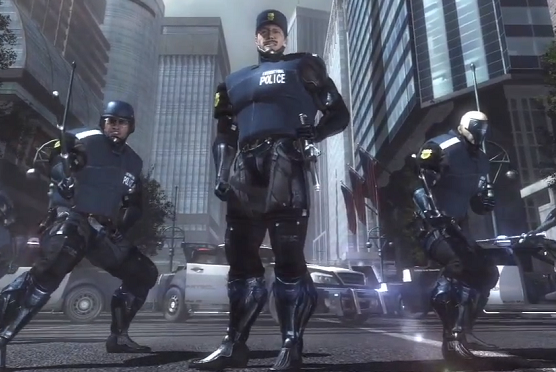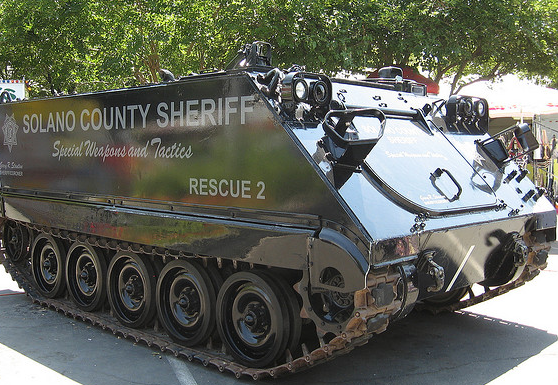This post has not been edited by the GamesBeat staff. Opinions by GamesBeat community writers do not necessarily reflect those of the staff.

The year is 2018, and a disrupted war economy has plunged the world into financial instability. But money hungry arms dealers and corrupt politicians scheme to rejuvenate their cash flow through child-cyborg experimentation and a staged terrorist attack. This dark glimpse of our possible future is the backdrop of Platinum Games’ “lightning fast” action game Metal Gear Rising: Revengeance.
As outlandish as the Rising’s depictions of 2018 are, Kojima Productions is a master of making the outlandish seem totally plausible. But of all the wild predictions made by Rising, the most plausible is also the most underplayed: the militarization and subsequent privatization of America’s police forces.
Rising only explicitly shows the Denver City Police Department as a privatized force owned and run by World Marshall Inc., America’s largest private military company and one half of the game’s antagonists; however, in protagonist Raiden’s codec conversations with Maverick military strategist Kevin, it’s revealed that an unspecified number of other cities also have privatized their police forces. While Kevin is quick to note that the majority of Denver’s police are unmodified humans, the city’s highly militarized SWAT unit is entirely comprised of cyborgs and weaponized robots. But will such heavily armed units really have a place in the future of America’s law enforcement?
The idea of a police unit dedicated to tackling high-risk operations was originally conceived in 1967 by Daryl Gates and further developed by John Nelson of the Los Angeles Police Department. Comprised of specially trained and equipped LAPD officers, the Special Weapons and Tactics (SWAT) unit found early success in their 1969 raid on the Black Panther head quarters and 1974 siege on a Symbionese Liberation Army stronghold. Since that time, SWAT units have been established in every major police force across the U.S., neutralizing immediate and deadly threats deemed too risky for uniformed police officers.
Following the terror attack on 9/11 in America and the subsequent War on Terror, however, the noticeable increase in usage of SWAT teams to carry out non-life threatening tasks — and the increased militarization of both SWAT and members of uniformed police — has been questioned.

The beginning of March saw the American Civil Liberties Union (ACLU) announce their nationwide investigation into the increased presence of militarized police units in American towns and cities. The organization’s concerns are laid out on its website and backed up by ten “chilling” news stories of botched drugs raids, inappropriate handling of protesters, and the shooting and death of those mistaken as combatants.
While one of the ACLU’s main goals is to curb what it sees as a growing trend in “overly aggressive policing,” their focus also falls on the extent to which federal funding is fueling police militarization.
In Metal Gear Rising: Revengeance, World Marshall is not only providing the entirety of the Denver City Police Department’s personnel but also their weapons and vehicles and the SWAT teams’ cyborgs and robots. Real-world police forces, on the other hand, currently receive a significant amount of equipment from the Department of Defense’s Excess Property Program.
Also known as the 1033 program, the Excess Property Program sees the Defense Logistics Agency hand out free army surplus weapons and armor as well as land, air, and sea vehicles. Government statistics show that the demand for this service has increased dramatically over recent years with police forces acquiring $2.12 million worth of military equipment in 2010, $4.98 million in 2011, and a staggering $5.46 million in 2012.
The Department of Homeland Security (DHS) also awards grants to local police departments that, according to a report by the Center for Investigative Reporting, have totaled over $34 billion since the 9/11 terrorist attacks. These hefty grants are used, among other things, to pay for military-grade equipment and training from defense contractors.

Radley Balko, policy analyst for think-tank Cato Institute and author of several white papers on civil liberties and paramilitary policing, believes that the large DHS grants have cemented defense contractor-police relationships across America. In an interview with Motherboard, Balko voiced his concerns over where these growing trends may lead to in the near future.
DHS grants are lucrative enough that many defense contractors are now turning their attention to police agencies — and some companies have sprung up solely to sell military-grade weaponry to police agencies who get those grants.
That means we’re now building a new industry whose sole function is to militarize domestic police departments. Which means it won’t be long before we see pro-militarization lobbying and pressure groups with lots of (taxpayer) money to spend to fight reform. That’s a corner it will be difficult to un-turn. We’re probably there already. Say hello to the police-industrial complex.
Unnervingly enough, Balko’s argument reads as though it has come straight from the script of an unreleased section of the Metal Gear saga. In fact, to take his Metal Gear-esque prediction of a police-focused arms industry a few steps further would see it fall in line with the same predictions made in Metal Gear Rising: Revengeance. After all, defense-contractor-owned, privatized police forces and the rejuvenation of Metal Gear Solid 4’s “war economy” within American borders was precisely the dream of Senator and Rising boss Steven Armstrong.
Walking tanks and full body cyborgs aside, Kojima Productions’ vision of privatized police forces may just be its most accurate.
